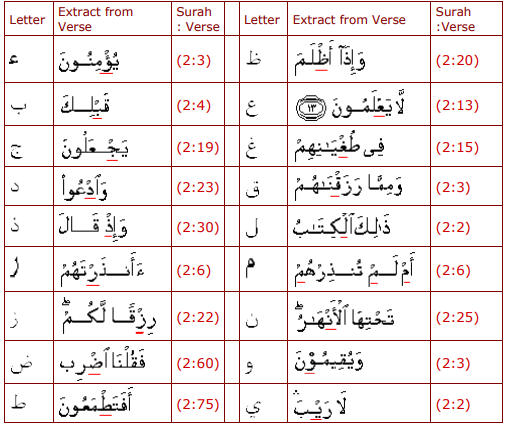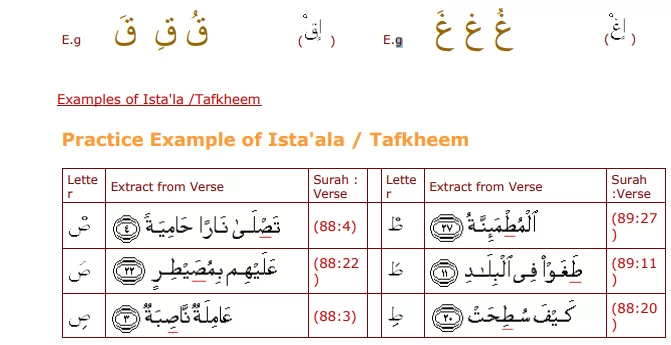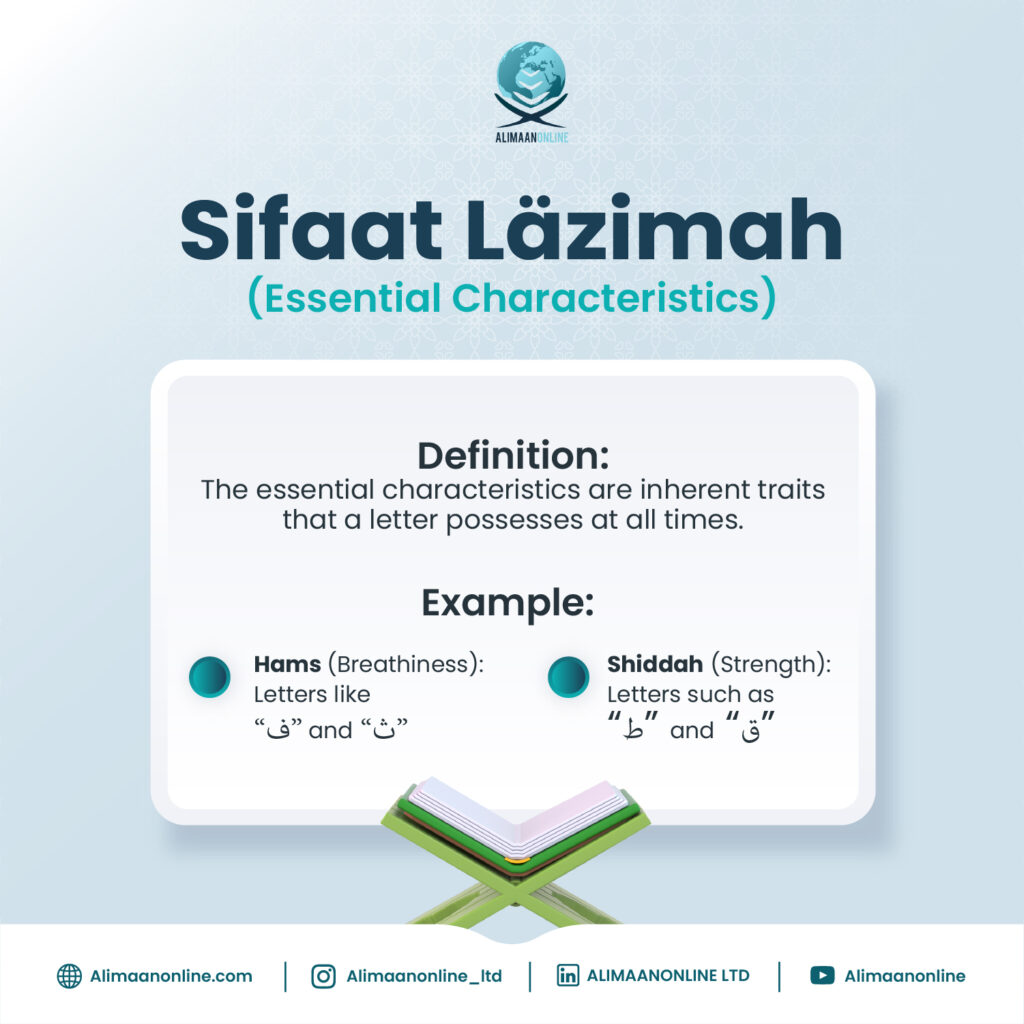Understanding the Sifaat Läzimah with opposites is essential for mastering the proper pronunciation of Arabic letters. These permanent characteristics of letters help define their articulation and sound properties. Each of these characteristics has a direct opposite that changes how a letter is pronounced.In this article, we will discuss these pairs in detail, providing definitions, examples, and explanations to enhance your knowledge of Tajweed.
1. Aljahr (الجهر) <-> Alhams (الهمس)
Alhams (الهمس)
Literal meaning: Whispering
Technical meaning: The slight continuation of breath upon pronunciation of a letter due to weakness in its point of articulation, especially when it carries a Sukoon.
Letters: (فحثه شخص سكت)
Examples:
- The letter “ف” in “فهم” has a slight breathy sound.
- The letter “ث” in “مثل” has a whispering quality when pronounced with Sukoon.
Note: The whispering sound remains when the letter has a Harakah but is less pronounced.

Aljahr (Opposite of Alhams) الجهر
Literal meaning: to be apparent
Technical meaning: The stoppage of breath upon pronunciation of a letter due to strength in it’s point of articulation when it carries a Sukoon.
Letters: All remaining letters are known as Majhoorah.
Examples:
- The letter “ب” in “سبب” has a full closure of breath.
- The letter “ج” in “جبل” is pronounced with a stopped airflow.

2. Ashiddah (الشدة) <-> At-Tawassut (التوسط) <-> Arakhawa (الرخاوة)
Shiddah (Opposite of Rakhawa) الشدة
Literal meaning: strength
Technical meaning: the discontinuation of the sound when pronouncing the latter, due to strength at its point of articulation
Letters: (أجد قط بكت)
قطب جد: Jahr and Shidah letters
ك & ت:Hams and Shidah letters
ء: Jahr and Shidah
Examples:
- The letter “ق” in “قلب” is pronounced with full closure.
- The letter “ط” in “طريق” is stopped at its Makhraj.
At-Tawassut (التوسط)
Literal meaning: Moderation
Technical meaning: This is a moderation between Shiddah and Rakhawa. The sound neither completely cuts off nor fully flows.
Letters of At-Tawassut: (لن عمر)
These five letters are called mutawassitah because their pronunciation starts at a defined articulation point, but the sound resonates beyond it, creating a moderate flow.
How Sound Travels:
ر (Raa): The tongue’s tip makes contact with the upper gums, yet the sound vibrates and is heard further in the mouth.
ل (Lam): The sound begins at the sides of the tongue touching the upper molars, but then it disperses forward in the mouth.
ن (Noon): The sound originates from the tip of the tongue against the upper gum but also resonates in the nasal cavity.
ع (Ain): This sound starts deep in the throat but can be heard moving slightly forward in the vocal tract.
م (Meem): The articulation begins at the lips, but the sound extends through the nasal passage.
Examples:
- The letter “ن” in “من” has a moderate flow.
- The letter “ل” in “ليل” is neither completely stopped nor free-flowing.
Arakhawa (الرخاوة)
Literal meaning: softness
Technical meaning: The continuation of sound upon pronunciation of a letter when it carries a Sukoon in a soft and gentle manner.
All the letters except the letters of Shiddah and At-Tawassut has this quality
Examples:
- The letter “س” in “سما” flows smoothly when pronounced.
- The letter “ش” in “شمس” allows sound to continue.
3. Isti’laa (الاستعلاء) <-> Istifaa (الاستفال)
Isti’laa (الاستعلاء)
Literal meaning: elevation
Technical meaning: The elevation of the back of the tongue towards the upper palate, producing a thick, round sound.
Letters: (خص ضغط قظ)
Examples:
- The letter “خ” in “خلق” is pronounced with a raised tongue.
- The letter “ظ” in “ظلم” has a heavy, full-mouth pronunciation.

Istifaal (Opposite of Isti’laa) الاستفال
Literal meaning: lowering or dropping
Technical meaning: The lowering of the tongue away from the roof of the mouth upon pronunciation.
Letters: All remaining letters are Mustafilah.
Examples:
- The letter “ت” in “تراب” is pronounced with a lowered tongue.
- The letter “ي” in “يوم” has a flat pronunciation.
The Five Levels of Heaviness
The Arabic letters vary in terms of heaviness (Tafkheem). These fall into five categories:
| Level | Example Letters | Examples |
|---|---|---|
| 1. A heavy letter with a Fatha followed by a lengthened Alif (Alif Maddiyya) | خ، ص، ض، ط، غ، ق، ظ | خَالِدٌ، صَابِرٌ، ضَالٌّ، طَالِبٌ، غَافِلٌ، قَائِمٌ، ظَالِمٌ |
| 2. A heavy letter with a Fatha | خَ، صَ، ضَ، طَ، غَ، قَ، ظَ | خَطَأٌ، صَبْرٌ، ضَرَبَ، طَلَبَ، غَفَلَ، قَلْبٌ، ظَلَمَ |
| 3. A heavy letter with a Damma | خُ، صُ، ضُ، طُ، غُ، قُ، ظُ | خُطُوطٌ، صُدُورٌ، ضُرُورَةٌ، طُفُولَةٌ، غُرُوبٌ، قُرْآنٌ، ظُلْمٌ |
| 4. A heavy letter with a Kasra | خِ، صِ، ضِ، طِ، غِ، قِ، ظِ | خِطَابٌ، صِدْقٌ، ضِعْفٌ، طِفْلٌ، غِفَارٌ، قِطَارٌ، ظِهْرٌ |
| 5. A heavy letter with a Sukoon | خْ، صْ، ضْ، طْ، غْ، قْ، ظْ | أَخْذٌ، فَصْلٌ، أَضْحَى، بَطْنٌ، إِغْلَاقٌ، فِرْقَةٌ، ظِلٌّ |
4. Infitaa (الانفتاح) <-> Itbaaq (الاطباق)
Itbaaq (الاطباق)
Literal meaning: adhesion
Technical meaning: adhesion is the adhesion of a large part of the tongue to the roof of the mouth when pronouncing the letters.
Letters: (ص ض ط ظ)
Examples:
- The letter “ص” in “صدق” closes the palate when pronounced.
- The letter “ض” in “ضوء” seals the mouth when articulated.
Infitaah (Opposite to Itbaaq) الانفتاح
Literal meaning: separation
Technical meaning: The separation of the tongue from the upper palate, allowing an open pronunciation.
Letters: All remaining letters are Munfatihah.
Examples:
- The letter “ب” in “بيت” pronounces openly.
- The letter “س” in “سلام” flows freely.
5. Idhlaq (الاذلاق) <-> Ismat (الاصمات)
Idhlaq (الاذلاق)
Literal meaning: fluency
Technical meaning: The ease and speed of pronunciation due to the simplicity of the Makhraj.
Letters: (فر من لب)
Examples:
- The letter “ف” in “فوز” articulates smoothly.
- The letter “ل” in “لبن” pronounces easily.
Ismat (Opposite to Idhlaq) الاصمات
Literal meaning: refusal
Technical meaning: The heaviness in pronunciation requiring effort in articulation.
Letters: All remaining letters are Musmatah.
Examples:
- The letter “د” in “درس” requires effort to pronounce.
- The letter “ق” in “قدر” needs controlled articulation.
Conclusion
Mastering Sifaat Läzimah with opposites ensures proper Tajweed. Understanding the characteristics of each letter ensures correct pronunciation and preserves the beauty of Quranic recitation. These features define the sound properties of Arabic letters, allowing learners to recite with clarity and precision.

